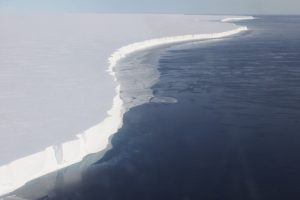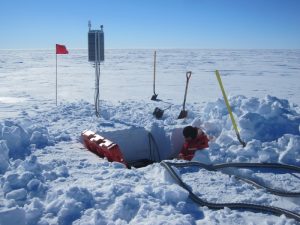8 August 2017
Tiny ocean waves could make large ice shelves crumble (plus VIDEO)
Posted by Lauren Lipuma

An aerial view of the Ross Ice Shelf. A new study finds ocean waves create vibrations in the Ross Ice Shelf that can weaken the ice shelf over time.
Credit: Peter Bromirski/Scripps/UCSD.
By Lauren Lipuma
Small ocean waves could play a bigger role in breaking up ice shelves than tsunamis or other large waves, a new study suggests.
A new study examining vibrations in Antarctica’s Ross Ice Shelf finds small waves continuously impacting the ice shelf may create enough strain to extend existing cracks in the ice and potentially create new ones. An ocean wave of 1 centimeter (0.5 inches) in height can cause vibrations that repeatedly move the ice more than 20 centimeters (8 inches), according to the new study in the Journal of Geophysical Research: Oceans, a journal of the American Geophysical Union.
The distance the ice moves is small, but because small ocean waves continually bombard the ice shelf, they could have a long-term effect on its stability, said Peter Bromirski, an oceanographer at Scripps Institution of Oceanography at the University of California San Diego and lead author of the new study.
Over time, these miniscule movements can initiate fracturing of the ice and Bromirski suspects these small waves could eventually trigger large slabs of ice to break off and float into the open ocean, a process called iceberg calving.
Previous studies have shown that tsunamis and other big ocean waves can cause large sections of the front end of an ice shelf to break off, but the new study suggests small ocean waves can have a similar effect.
Understanding how ocean waves impact ice shelves is important for determining future sea level rise, according to the study’s authors. Ice shelves act as buttresses to the grounded ice behind them, restraining the flow of ice into open water. When ice shelves break off, the buttressing effect goes away, allowing ice on land to move faster into the ocean, raising sea levels.
Scientists suspect ice shelf collapse events, such as Antarctica’s Larsen B ice shelf collapse in 2002, are due to a process called hydrofracturing, where ponded meltwater fills deep channels in the ice. But the new study’s finding adds another factor that can weaken ice shelves, Bromirski said. An iceberg the size of Delaware broke off Antarctica’s Larsen C ice shelf last month, but because this is the Southern Hemisphere’s winter, meltwater is not available to cause fracturing of the ice, he said.
“What triggers the final breakoff of these large tabular icebergs hasn’t been established yet, but our hypothesis is that ocean waves could provide the forcing,” Bromirski said. “What triggered the recent Larsen C iceberg calving in the middle of the austral winter is not known. But ocean wave activity could have provided the force needed to break the last segment still attached.”

Researchers install seismometers on the Ross Ice Shelf to measure vibrations caused by ocean wave impacts.
Credit: Peter Bromirski/Scripps/UCSD.
Taking the pulse of the ice
Bromirski and his colleagues traveled to Antarctica in 2014-2016 to better understand how ocean waves affect ice shelves. The researchers set up an array of seismometers on the Ross Ice Shelf – Antarctica’s largest ice shelf – to monitor its movements over the course of two years. In addition to detecting vibrations in the ice caused by tiny ocean waves, they also detected ice movements from a tsunami that resulted from the September 2015 Illapel, Chile earthquake.
They found that even though the Chilean tsunami was small when it reached Antarctica, only about a centimeter in height, it moved parts of the ice roughly 30 centimeters (12 inches) horizontally, potentially expanding existing fractures in the ice. Surprisingly, they also noticed that small, long-period ocean waves continuously produce similarly large vibrations in the ice shelf year-round.
They found that these much smaller waves can move the ice horizontally up to 20 to 30 centimeters (8 to 12 inches) over a period of 5 to 17 minutes. Because these waves repeatedly vibrate the ice, they could have a bigger effect on the evolution of an ice shelf than large tsunami waves that occur rarely, according to the authors.
“When you look at it from a long-term perspective, something that’s impacting the ice shelf continuously could have even a stronger effect than tsunamis, which are infrequent,” Bromirski said.
The authors also suspect ocean waves could have an even bigger impact on Antarctica’s ice shelves in the future. As the climate warms, stronger storms could bring warmer ocean water and more frequent waves to the southernmost continent, thinning and weakening the ice shelves over time and making it easier for the ice to fracture.
— Lauren Lipuma is a senior public information specialist and writer at AGU. Follow her on twitter at @Tenacious_She.


 GeoSpace is a blog on Earth and space science, managed by AGU’s Public Information staff. The blog features posts by AGU writers and guest contributors on all sorts of relevant science topics, but with a focus on new research and geo and space sciences-related stories that are currently in the news.
GeoSpace is a blog on Earth and space science, managed by AGU’s Public Information staff. The blog features posts by AGU writers and guest contributors on all sorts of relevant science topics, but with a focus on new research and geo and space sciences-related stories that are currently in the news.